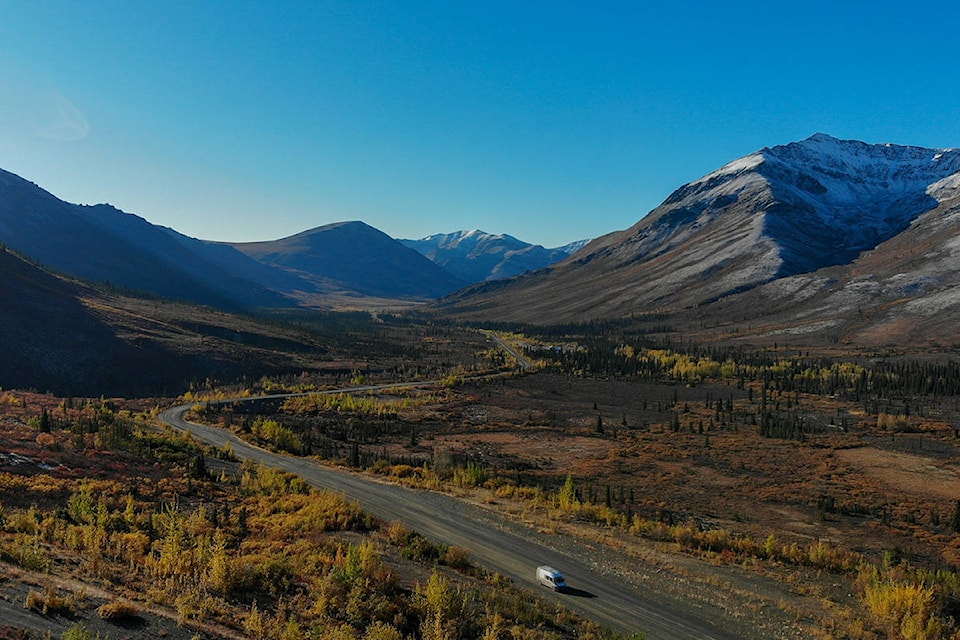- Story and photography by Darren Hull
Story courtesy of , a Black Press Media publication
Like Boulevard Magazine on and follow them on
Photographer and filmmaker Darren Hull — whose work is featured regularly in Boulevard Okanagan — travelled solo to Canada’s North to explore and photograph the Dempster Highway and document the only open road to the Arctic Ocean.
The Dempster Highway has been around since 1979, but the Inuvik–Tuktoyaktuk Highway officially opened November 2017 and is the first all-weather road to Canada’s Arctic coast. It is an engineering marvel, making it an enticing “bucket list” item, explains Darren. A 740-kilometre roadway from Dawson City, Yukon to Inuvik, Northwest Territories, the trip offers incredible scenery, wide-open spaces and remote beauty with the option to carry on north to Tuktoyaktuk and the Arctic Ocean.
My journey started in Kelowna, where I boarded a plane and flew to Whitehorse with the friendly folks at AirNorth. I was treated to a lovely in-flight meal of local cheeses, bison and crackers, followed by the best warm chocolate chip cookie of my life. It was an easy flight, just over two hours (a little more than three hours from Victoria).
After I landed in Whitehorse, the folks at DrivingForce provided me with a fully loaded SUV rental; it had enough room for myself and all my gear to be self-contained throughout my journey.
I was tempted to explore all that Whitehorse offered, but I had to keep my focus on the Dempster, and my journey ahead.
After catching some shut-eye, I rose early and supplied-up with the items I couldn’t fly with: fuel for my camp stove, water and food for the entire duration. I knew that Whitehorse was the biggest city stop for this trip and had the most amenities, so I took the opportunity to stock up and avoid purchasing groceries and supplies that would get increasingly expensive, the further north I travelled.
Fully stocked and ready to go, I drove the six hours from Whitehorse to Dawson and spent the night. I’d always wanted to explore Dawson and it was a great place to start my Dempster Adventure, with the highway just one hour away.
The highway cuts through two mountain ranges, the Ogilvie and Richardson Mountains, through miles of forests and arctic tundra, before dropping to the Mackenzie River and its flats.
The highway sits on top of a gravel berm to insulate the permafrost in the soil underneath. The thickness of the gravel pad ranges from 1.2 metres up to 2.4 metres in some places (four feet to eight feet). Without the pad, the permafrost would melt and the road would sink into the ground.
The Dempster Highway has long been a quiet magnet for adventurous travellers. It seems to be even more of a draw now that drivers can continue on from Inuvik to the Arctic coastal community of Tuktoyaktuk.
Services are limited and the journey on the Dempster can be hard. The first stretch runs 370 kilometres without a gas station. Gas, diesel fuel and repairs are available at Eagle Plains, Fort McPherson and at Inuvik. Appropriate preparation is essential. Road conditions can also vary drastically.
Inuvik is the official end of the Dempster Highway, but you can’t just stop there with the Arctic Ocean only 140 kilomtres away on the Inuvik–Tuktoyaktuk Highway.
It took two and a half hours to reach Tuktoyaktuk (Tuk), where there was a small collection of campers parked around a spanking new Arctic Ocean sign.
I was on the road for eight days in total, and with a day each before and after, my adventure took a total of 10 days.
There are no hotels in Tuk yet, only a few small bed and breakfasts. I drove to Tuk and back in a single day and used Inuvik as my base for the Northern Arctic adventure. For those willing to dry camp, people are welcome to park near the beach in Tuk for free. My regret was not spending more time there; I will plan for more days on my next adventure there.
This was a trip that I will never forget. The scenery was comparable to none, but it was also long, dirty and lonely at times. It seemed to be a place you could disappear and never be seen again. The road was not only physically rough, but it was rough on the vehicle and my body and mind. The change in the road conditions — from hard compact gravel to mud bogs —
kept me on alert. There were hours that would go by without seeing another vehicle on the road. Aside from the road itself, it was the most untouched landscape I’d ever seen.
The week was filled with every imaginable weather condition. The colours in early September were spectacular and the lack of bugs around that time was an added bonus. I had heard some reports of heavy insects during other times of the year, so I was happy I travelled in September.
It’s a trip I know I will need to take again, and the planning is already underway.
To see more from photographer Darren Hull check out his website



